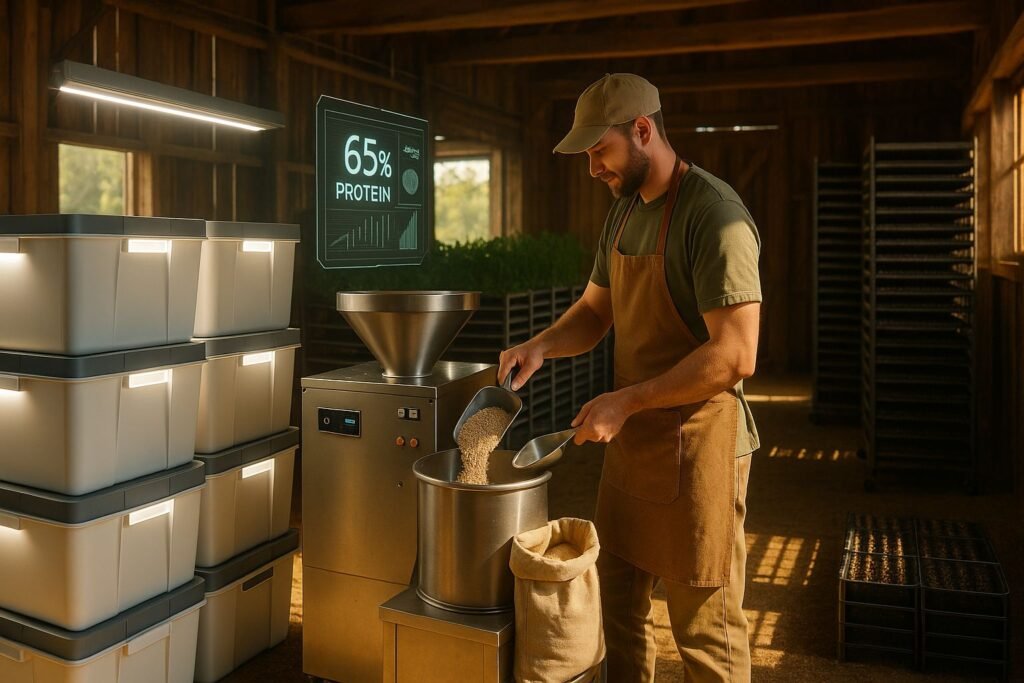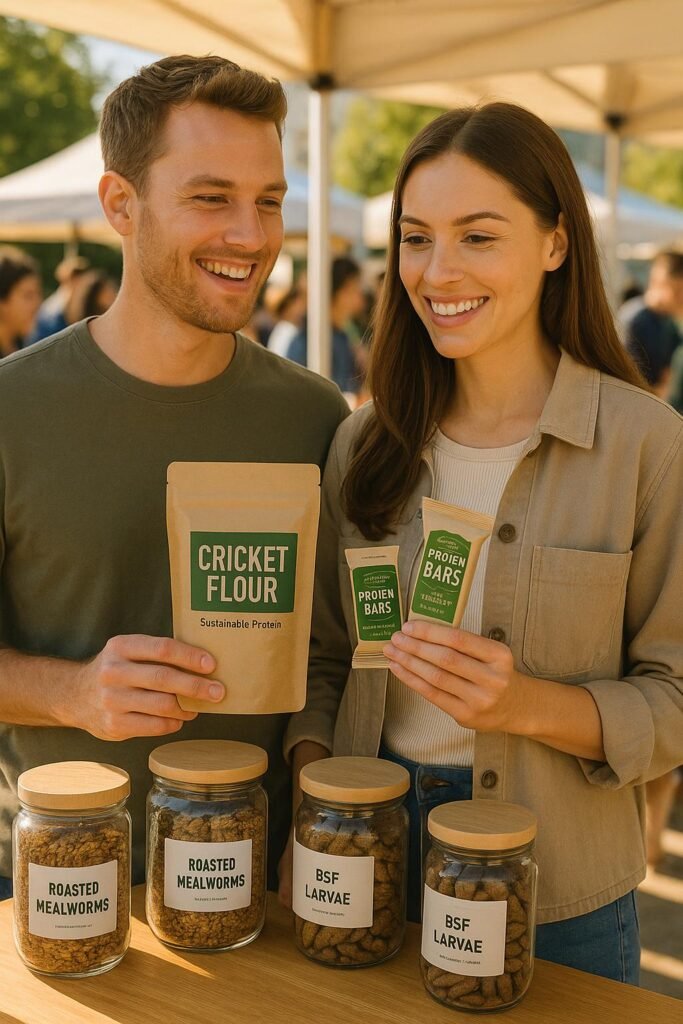1. Introduction: The Future of Sustainable Protein
In 2025, insect protein is emerging as a sustainable solution to global food and feed challenges. With the global edible insect market projected to hit $9.6 billion by 2030 (Meticulous Research), interest is booming—especially in the US, Canada, and Europe. Around 41% of Europeans and 35% of North Americans now recognize insects as a sustainable food source (Barclays Research). For small farm owners and Agri entrepreneurs, insect farming offers a low-cost, high-return path into sustainable agriculture.

2. Why Start Insect Protein Farming?
Insect protein is no longer a fringe concept—it’s fast becoming a cornerstone of sustainable agriculture. With surging demand, low production costs, and incredible efficiency, insect farming offers small farms a gateway to enter a booming industry that aligns profit with planet.
Market Growth & Environmental Benefits
- The insect protein market is growing at a 26.5% CAGR, with surging demand in Western countries.
- Crickets require 12x less feed than cattle and emit significantly less greenhouse gas (FAO).
- Insects support sustainable protein farming and circular agriculture by converting food waste into protein and fertilizer.
Rising Consumer & Industry Demand
- 42% of US millennials are open to insect-based foods (YouGov, 2024).
- Companies like Ynsect and Aspire Food Group are investing in insect-based products for humans, pets, and livestock.
3. How to Start Insect Protein Farm (Step-by-Step)
Starting an insect protein business doesn’t require vast land or complex infrastructure. With a small space and modest investment, smallholders can build a scalable operation. Here’s how to take your first steps.
Top Insects to Farm
| Insect | Use | Pros |
|---|---|---|
| Crickets | Human food, pet treats | Easy to breed, high in protein |
| Mealworms | Flour, feed | Low maintenance, good for baking |
| Black Soldier Flies | Animal feed, composting | Thrive on waste, rapid growers |
Setup Guide
- Space: A 500 sq. ft. setup can yield 100–150 kg/month.
- Costs: Initial investment ranges from $1,000 to $5,000.
- Supplies: Plastic bins, trays, heating, ventilation, and starter stock.
- Suppliers: Entomo Farms, Next Millennium Farms.
4. Regulatory Requirements (US, EU, Canada)
As insect farming gains legitimacy, governments are catching up with regulations. Understanding the legal landscape is key to scaling your insect protein business without roadblocks.
- USA: FDA approves insects like crickets and mealworms under GRAS.
- EU: Novel Food Regulation allows edible insects post-2021.
- Certifications: Organic, GMP+, HACCP depending on product use.
5. Is Insect Farming Profitable?
Profitability in insect farming depends on smart planning and diversified revenue streams. Many small farms have already found success by tapping into the growing demand for sustainable protein.
Success Stories from the Field
1. EcoGrubs Farm – Ontario, Canada
“We started small in our garage with just $3,500. Now we supply cricket powder to health stores across Ontario. It’s been life-changing not just for our income, but for how we connect with our community about sustainable food.”
— Sarah K., Co-founder of EcoGrubs
2. TinyProtein – Oregon, USA
“People were skeptical at first. But after trying our roasted mealworms, local chefs and pet food retailers kept coming back. Insect protein isn’t a trend—it’s the future.”
— Jared M., Owner of TinyProtein Farm
3. BioBugs Coop – UK
“With minimal land and a lot of motivation, our cooperative began exporting black soldier fly larvae for aquaculture feed. The EU’s sustainability funding really helped us scale up.”
— Emma L., Cooperative Manager
Business Models
- Human Food: Cricket flour, roasted snacks
- Animal Feed: For poultry, fish, pets
- Byproducts: Frass (organic fertilizer)
Example Case
- EcoGrubs Farm (Canada) launched with $3,500 in 2021 and reached $60,000+/year selling cricket powder by 2024.
Cost Snapshot
| Expense Type | Cost (USD) |
| Setup | $1,000–$5,000 |
| Monthly | $200–$500 |
| Break-even | 6–12 months |
6. Marketing Insect Protein to Western Consumers
Western consumers are increasingly open to alternative proteins—but marketing insect-based products still requires creativity and education. Here’s how to connect with your audience and drive demand.
Overcoming Barriers
- Educate consumers on nutrition and sustainability.
- Offer tastings at local events.
- Emphasize eco-benefits and innovation.

Sustainable food isn’t just a trend, it’s a movement. Young consumers across Western countries are turning to protein alternatives that reflect their values, like environmental care and ethical sourcing. Products like cricket flour and insect-based protein bars are now being sold at farmers markets and health stores, making sustainable protein feel less “experimental” and more every day.
This shift is especially popular among millennials and Gen Z, who prioritize nutrition, transparency, and eco-impact when they shop. These aren’t novelty snacks, they’re staples in modern kitchens.
🛍️ “We discovered cricket protein at our local market. It’s clean, healthy, and actually delicious in pancakes!” — says a young couple in Vancouver.
Sales Channels
- Health food stores, Shopify, Amazon, pet supply chains
- B2B with protein snack brands or organic farms
7. Final Thoughts: Small Steps to Big Impact
Insect farming offers a rare combination of accessibility, profitability, and sustainability. For small farm owners, it’s a smart way to future-proof your operations while contributing to global food security.
Insect farming is no longer fringe—it’s a legitimate, profitable, and eco-friendly business model for small farms. Whether you choose to raise mealworms, crickets, or black soldier flies, the opportunity in 2025 is real.
Start small, learn quickly, and scale sustainably.
Want help getting digital marketing services? Visit and choose our SERVICES
Resources
- FAO Report on Edible Insects
- Barclays Research on Insect Protein
- Meticulous Research on Insect Farming